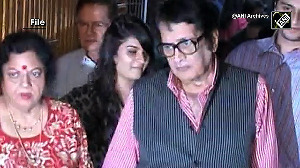Obsessions take different shapes. For Ashish Anand, 34 years old and peripatetic by nature, it has assumed the form of a gargantuan greed. Every day of every week, Anand plots and strategises about how he will buy more art.
There are scores of collectors in the country who probably plan to acquire new works, but in the case of Anand, the term "more" doesn't mean just a few more canvases, not even a few hundred canvases, but, quite literally, thousands upon thousands of canvases.
Out on the street, you wouldn't given Anand a second look. Typical of the generation, he's well dressed, wears his hair trendily, a faint accent laces his conversations.
But what sets him apart is his drive to become one of the largest collectors of art -- and not just in India, but in the world. Already, he has perhaps 10 godowns where framed works stand in piles, while those that aren't framed are stored in vast drawers.
But he's a bit of a collector-come-lately in the trade, someone who admits he entered the profession because of the financial opportunity he saw in it, before becoming a worshipper at the altar of aesthetics.
"My family manages a garments business," he says, and he had joined his brothers for a while before borrowing money from them to start buying art in 1999. For two years before that, Anand had studied the market for contemporary art in the country.
"I travelled all around, visited museums and galleries, artists and collectors. I was intrigued how 10-15 artists sold so well while scores of others were undervalued. I wanted to correct that disparity."
He began by buying out complete studios either from artists or their families. Among those he bought out were Gogi Saroj Pal, Himmat Shah, Rabin Mondal, Sunil Das, J Sultan Ali, Laxman Pai, Gopal Ghose and Chittaprosad Bhattacharya.
He also bought complete collections from collectors -- "I've been called a tough negotiator," he admits -- because he wanted to do books, host retrospectives, set up an authentication department and so on.
In Delhi's Hauz Khas Village, his Delhi Art Gallery -- over three levels, with several storage pits -- is just a temporary address.
He hopes soon to be able to build a 50,000 sq ft gallery -- "it'll be the largest in the world," he says -- as part of a cultural centre where digitisation of all works of Indian contemporary art (including those in museums and collections around the world) will take place, there'll be a library, a restoration cell, an auditorium, bookshop, cafe and authentication centre, besides a connoisseurs club, art appreciation courses, an artists-in-residence programme and the like.
It is only in the last years that Anand has started showing parts of his collection through the half-yearly Manifestations shows -- the third edition opened this weekend in Delhi after closing down in Mumbai.
"But now, money is no longer the driving force," says Anand, who says the Rs 500 crore (Rs 5 billion) art market will burgeon to a Rs 5,000 crore (Rs 50 billion) market in another five years.
"Prices will increase tangentially," he promises, "and the number of people buying art will explode."
In anticipation of that he's planning restrospectives, films and books on Rabin Mondal, Sunil Das, Ambadas and Chittaprosad Bhattacharya within the year, and at least another six books (besides the biannual Manifestations catalogues) next year.
Each book has a print-run of 2,500-3,000 copies, and these are distributed free by DAG. Philanthrophy? Hardly. "The price of the featured artists rises 10 per cent every time I do a book on them," Anand says. Reason enough to understand why he says that "acquiring art is complete madness for me."







 © 2025
© 2025